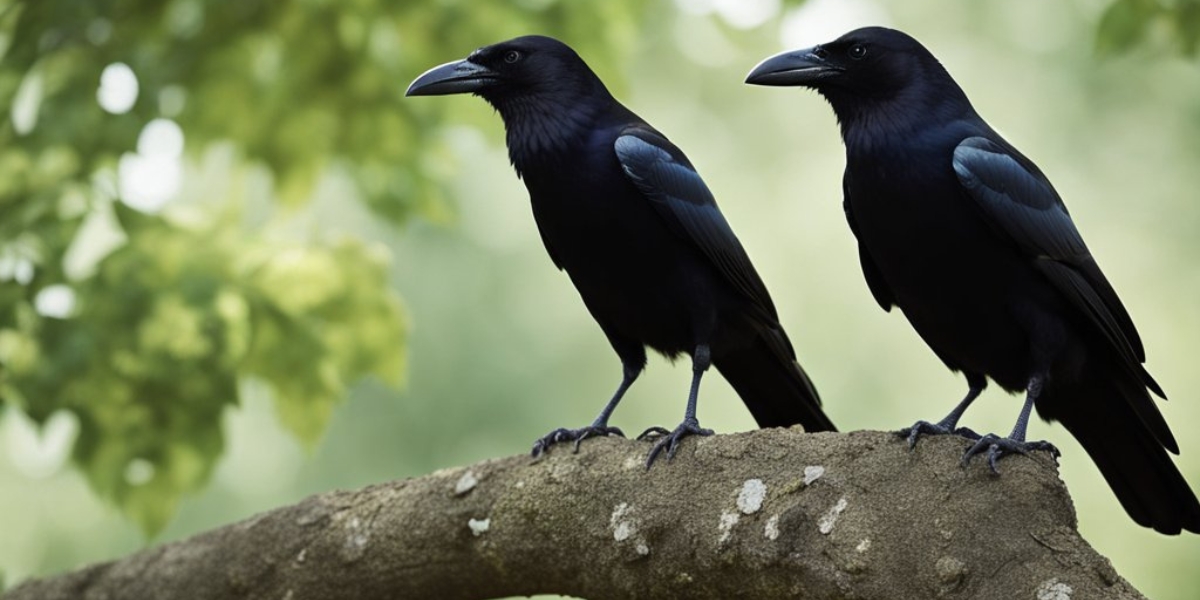Have you ever admired the intelligence and social nature of crows and wondered what it would be like to befriend these remarkable birds? By understanding crows and creating an environment that meets their needs, you can gradually build a bond of trust and form lasting friendships with the crows around you. This comprehensive guide covers everything you need to know to create rewarding relationships with these fascinating creatures.
Understanding Crows
Crows are highly social, intelligent birds that live in family groups called murders. Getting to know their behavior, communication styles, and body language is key to connecting with them.
Social Behavior and Intelligence of Crows
Crows are incredibly intelligent, with problem-solving abilities rivaling those of great apes. They have complex social behaviors and tight family bonds. Crows mate for life and live in family groups of up to 15 birds that work cooperatively to find food, defend territory, and raise young together.
Young crows stay with their parents for years, learning survival skills like identifying predators, tool use, and social interactions. Because of their strong family ties and intelligence, crows can recognize individual human faces and differentiate between those who help or harm them.
Crows’ Communication and Vocalizations
Crows have a vast vocabulary of sounds with specific meanings. They use different caws and calls to signal danger, mark territory, summon their mate, warn of predators, and signal feeding time to their young. Listening carefully and learning their vocalizations can help you understand Crow communication.
Crows also use nonvocal sounds like wing flaps, beak clicks, and tail spreads to signal alarms or get each other’s attention. Understanding the context around various crow calls and gestures will help you interpret their meaning.
Body Language and Gestures of Crows
Crows convey a lot through their body language. Watching how they position their wings, tail, and head provides insight into their mindset. For example:
- Wings flared wide, while cawing shows aggression
- Head bobbing signals a warning
- Tail fanning indicates alarm
- Crouching flat to the ground signals submission
Noticing small gestures and postures will help you read crows’ moods and react appropriately to avoid frightening them.
Creating a Crow-Friendly Environment
Providing a secure space with food, water, and shelter sources is key to attracting crows and making them comfortable around you. Consider the following when creating an inviting area for crows:
Choosing the Right Location
- Pick a quiet spot away from busy areas, predators, and noise pollution that might disturb crows.
- Ensure good visibility so crows can scan for danger. Tall trees or rooftops make ideal observation posts.
- Crows prefer grassy fields, open lawns, or parking lots for foraging. Nearby trees or shrubs provide cover and roosting spots.
Offering Suitable Food and Water Sources
- Crows are omnivores and opportunistic feeders. They enjoy peanuts, pet food, cracked corn, mealworms, hard-boiled eggs, fresh fruit, and even fast food.
- Provide food and water in a consistent spot so crows learn to return daily. Elevated feeders with a wide, sturdy platform work well.
- Ensure fresh, clean water daily. Crows enjoy bathing, so consider adding a bird bath.
Ensuring Security and Safety
- Avoid areas frequented by predators like hawks, owls, or cats that can injure or kill crows.
- Crows are wary, so minimize loud noises from machinery, vehicles, or leaf blowers that could startle them.
- Remove netting, strings, or wire fencing that could entangle and harm crows. Monitor for sharp objects like nails, glass, or metal scraps.
Building Trust and Connection with Crows
Gaining crows’ trust takes time and patience. Use these tips to show crows you’re friendly and establish a bond:
Earning Crows’ Trust Through Patience and Consistency
- Visit the feeding area at the same times daily. The crowds appreciate your routine and will look for you.
- Respect crows’ space and don’t make direct eye contact, which can seem threatening.
- Move slowly, speak softly, and stay calm. Sudden movements can startle them.
- Be patient. It can take many months of consistent, positive interactions before crows accept you.
Avoiding Sudden Movements and Loud Noises
- Make your presence known gradually when approaching crows to avoid startling them.
- Avoid quick gestures or loud voices which can signal danger to wary crows.
- If crows become alert or distressed, pause and give them space until they relax.
Using Positive Reinforcement and Treats
- Offer enticing foods like peanuts, cheese, or pet food as you arrive so crows associate you with rewards.
- Crows love shiny objects. As they get comfortable, share silverware, beads, hardware, or coins.
- Speak encouragingly when crows approach. Praise builds trust and reinforces bonding.
Communicating and Interacting with Crows
Once crows know you well, carefully try interacting using vocalizations, gestures, and by following their lead:
Learning to Recognize Different Crow Calls and Vocalizations
- Listen for distinct sounds like the “kowlp” alarm call or soft warble of contentment.
- Notice context so you learn what various calls convey. Mimic their noises as appropriate.
- Avoid noises like owl hoots that signal danger. Stick to soft cooing sounds and clicking your tongue to get their attention.
Understanding Crow Body Language and Gestures
- Read their posture and movements to understand their mindset before interacting.
- If wings are flared or the beak is agape, give them space and avoid prolonged eye contact.
- Relaxed, smooth feather patterns and eye blinking signal calmness. Caws or bowing posture can mean they are inviting your attention.
Using Vocalizations and Gestures to Communicate with Crows
- Get their attention with soft clicks. Offer peanuts when they turn toward you.
- Bow your head and avoid staring directly. Look for them to reciprocate this gesture of respect.
- Caw gently in response when they vocalize to you. Mimicking shows you understand them.
Tips for Successful Crow Friendship
Developing lasting friendships with crows requires dedication and respect. Use these tips for the best results:
Regular Feeding and Interaction
- Visit crows daily at the same time so they anticipate your arrival. Don’t skip days once you begin a routine.
- Slowly move closer as you provide food. Brief, pleasant interactions build bonds over time.
- Learn individual crows’ traits so you can recognize your crow friends.
Providing Nesting and Roosting Sites
- Place elevated bird houses or roosting platforms high in trees to provide safe spots for resting and raising young.
- Ensure the boxes are sturdy and sheltered. Line with peat moss, bark, or pine needles for nesting material.
- Protect nests from predators, and never disturb eggs or hatchlings.
Protecting Crows from Predators and Threats
- Keep alert for local predators like hawks that can injure crows. Discourage those predators from frequenting your area.
- Ask neighbors to avoid harming crows. Be vigilant for threats like poison, traps, or vehicles.
- Report injured crows to wildlife rehabilitators. Don’t intervene with baby crows, as parents are likely nearby.
Precautions and Considerations
While forging connections with crows can be extremely rewarding, you must remain respectful of their space and needs:
Maintaining Responsible and Ethical Interactions
- Don’t ever capture or restrain crows. Admire them from a distance as wild creatures.
- Ensure young crows can’t become imprinted on or dependent on you. Allow parents to raise nestlings naturally.
- Avoid disturbing family group dynamics or mating pairs. Be mindful not to disrupt their natural social order.
Dealing with Common Challenges and Conflicts
- Crows can become territorial and aggressive if they feel threatened. Remove potential roosting spots near your home.
- To discourage bad behavior, stop rewarding crows with food if they become demanding, damage property, or attack people.
- Seek advice from wildlife experts if conflicts occur, and consider discouraging crows from overly relying on your home for resources.
Reporting any Signs of Illness or Distress in Crows
- Call wildlife rehabilitators if you notice injured crows that need medical care and recovery before release.
- Report strange behaviors like lethargy, weakness, or isolation from the flock that could signal illness or parasites so biologists can investigate.
- Don’t interact closely with crows exhibiting sickness to avoid spreading disease. Monitor them from a distance instead.
Additional Resources and Information
Connecting with crows can open up a fascinating world. Leverage these resources to enrich your understanding and experiences:
Crow Conservation Organizations and Resources
- The National Audubon Society’s Project SOS – Works to protect crows and other birds through conservation initiatives.
- Seattle Audubon Society – Offers classes on crow communication and interactions with people.
- Avian Welfare Coalition – Rehabilitates injured crows and studies urban crow populations.
Books, Websites, and Documentaries about Crows
- The American Crow and the Common Raven by Kevin McGowan – Details crows’ biology, behavior, and expanding urban populations.
- In The Company of Crows and Ravens by John Marzluff – Fascinating first-hand account of befriending and studying corvids.
- PBS Nature Documentary “A Murder of Crows” – Reveals crows’ intelligence through hidden camera footage of their behaviors.
Opportunities for Crow-Related Activities and Events
- Crow festivals like Evansville’s Funky Crows Festival – Celebrate crows through arts, crafts, lectures, and field trips.
- Join the Cornell Lab of Ornithology’s Crow Research Portal – Share observations, ask questions, and participate in crow behavior studies.
- Visit wildlife rehabilitation centers during crow treatment – Observe care and release of injured crows by trained professionals.
People Also Read:
- How to Make Friends With Birds?
- Where Do Birds Go During Hurricanes?
- 10 Creative Ideas – How To Play With Your Bird
Conclusion
Crows offer an opportunity to connect with nature in a remarkable way. By understanding crow behavior and creating an inviting environment, you can gradually befriend crows around you. Stay patient, consistent, and respectful as relationships develop through small gestures of trust over time. The companionship and joy of bonding with these intelligent, social birds is well worth the effort. May the tips in this guide help you forge new friendships with the crows in your neighborhood!
FAQs
What is the best time of day to interact with crows?
Early morning, when crows are scavenging for food, is often ideal. Crows recognize faces best in good daylight. Avoid dusk when they are roosting.
How close should I get to crows when feeding or interacting with them?
Keep at least 10 feet away initially. Once they accept you, you can slowly move to around 6 feet as comfort levels increase. Avoid crowding them.
How can I tell individual crows apart when I begin feeding them regularly?
Watch for distinguishing traits like unusual feathers, beak shapes, scars, or different markings. Named bands on their legs can also help identify individuals.
What precautions should I take to avoid scaring away crows that frequent my yard or property?
Move slowly and speak softly. Avoid direct eye contact. Face away, and tangentially “monitor” crows from the corner of your eye. Sit still and allow them to adjust to your presence.
How will I know when wild crows have come to accept and trust me?
Signs include coming very near, showing less wariness, appearing relaxed and content, preening themselves around you, and bringing you gifts like shiny objects or food morsels.

